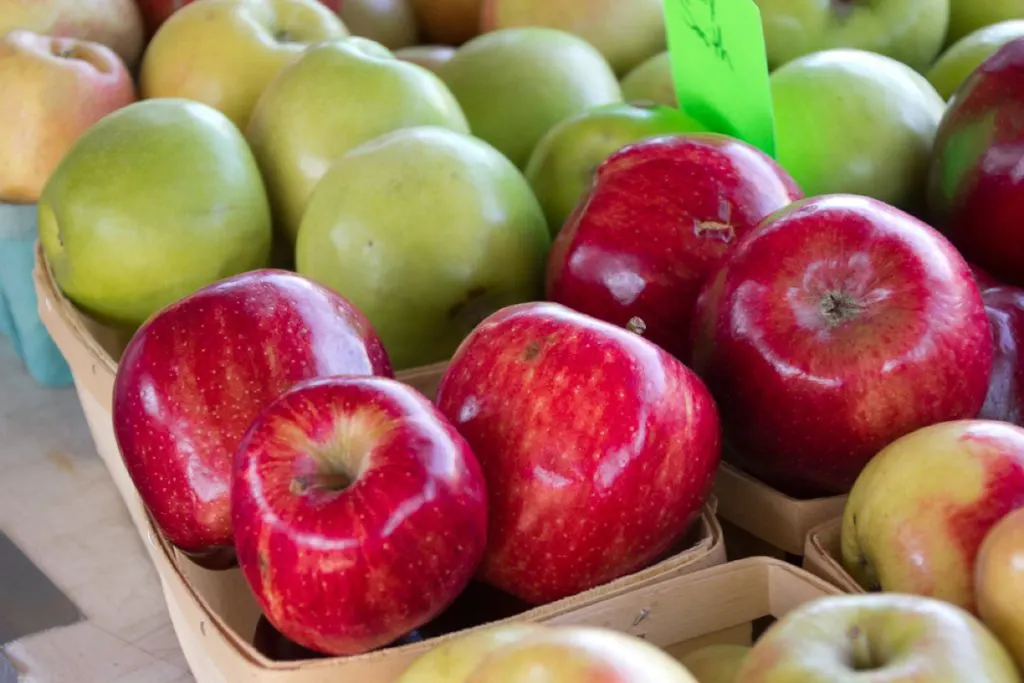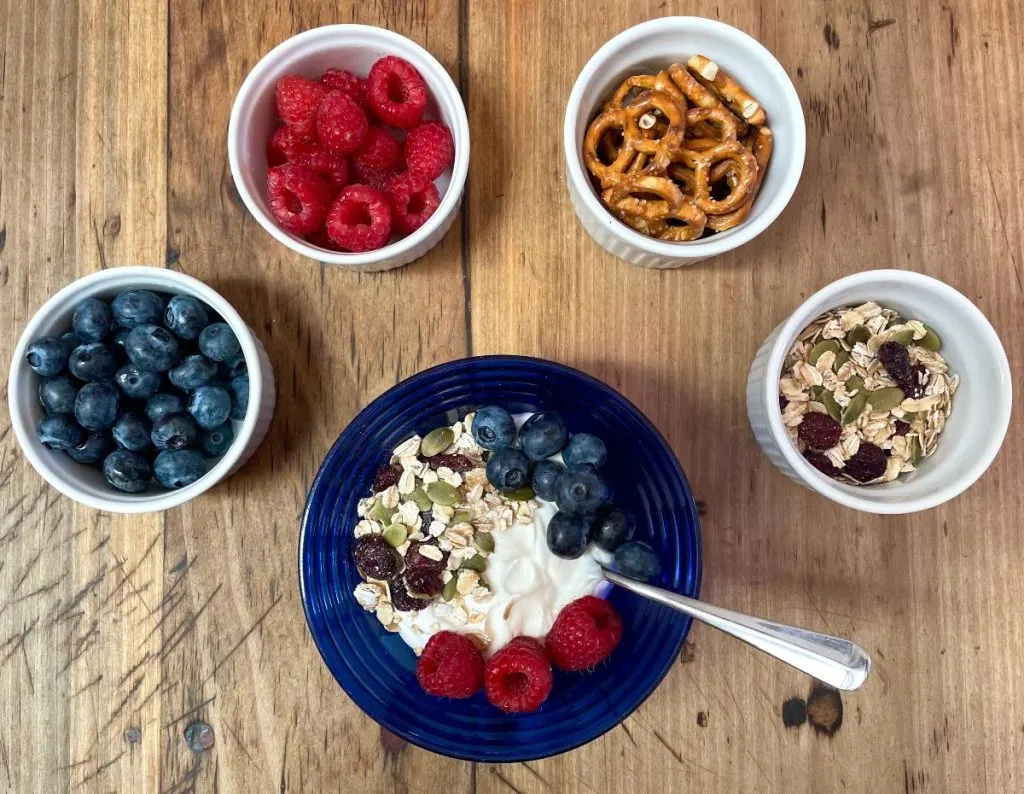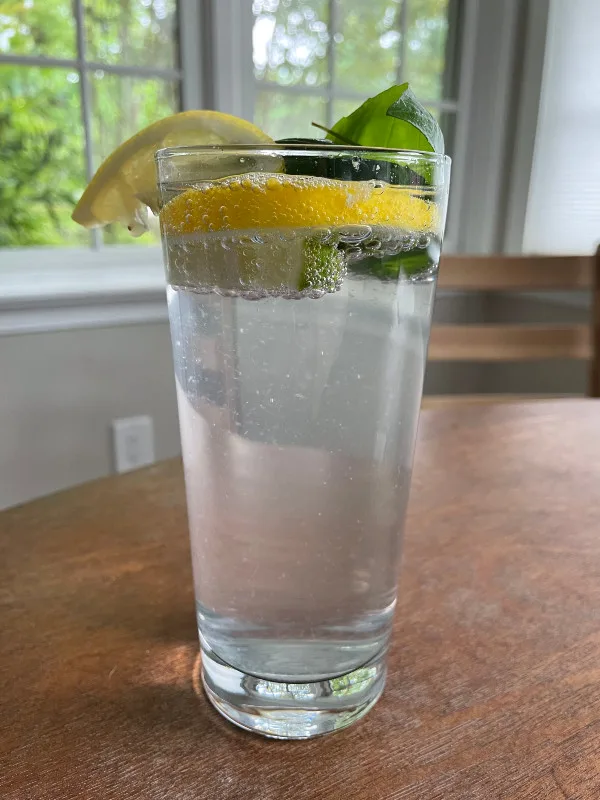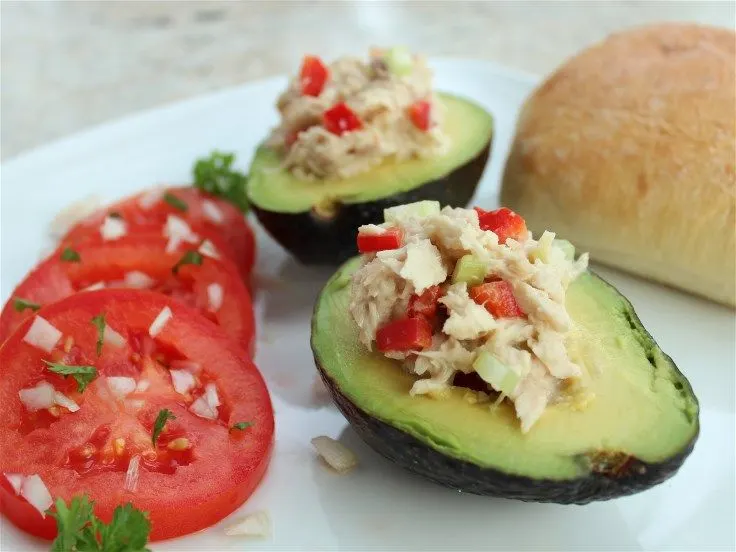Perimenopause and the early stages of menopause is a hugely transitional time for women. Not only are our bodies changing (sometimes dramatically), but we are also forced to come face to face with the reality that we are older and need to pay closer attention to our health and well-being. And with that recognition comes a sometimes uncomfortable question: what should I eat during perimenopause and menopause so that I can live a long and healthy life (and maybe fit back into my favorite pair of jeans again)?

If you are in the midst of perimenopause or the early years of menopause, the changes in our bodies, not just over time but even day to day, can be a shock. Not only can these changes throw us for a body-conscious loop, but they can also force us to confront the reality that what we do now will impact how we age further down the line.
If you have ever looked into the question, what should I eat during perimenopause and menopause, you will know that the information that is out there can be really overwhelming. The lists of all the foods you “should” eat every day can be daunting and lead you wondering either how am I going to get all of this food into my body every day without losing my mind? Or will I ever get to eat fun foods again?
Well, I’m here to try to assuage your fears a bit. I’ll start by explaining why making some changes to your diet (or at least paying a little bit of attention) is probably worthwhile, then I’ll give you an overview of what foods are helpful during perimenopause and menopause, and finally I’ll offer a re-frame that I hope will help you to enjoy your food and feel at peace with your diet.
Before I go any further, though, I want to be clear: I am not prescribing a diet. I am sharing general recommendations. If you are going to make any major changes to your diet, I would suggest talking to your doctor or a nutritionist to figure out what is best for you.

Why Does What I Eat During Perimenopause and Menopause Matter?
As we age, there are certain health concerns that start to become more prevalent, many of which can be impacted by our diet and nutrition. These include, bone health, cardiovascular health, digestive health, and neurological/cognitive health. Here is a little overview on each.
Bone health
Did you know that our bones are constantly changing? You can think of our bones as kind of like an ecosystem in which the old bone die away and new bone is formed. As we get older, the bone breakdown and reabsorption starts to happen faster than the new bone formation does, which can lead to osteopenia and osteoporosis. This is true for all humans, but is especially true for women in perimenopause and menopause because our sex hormones, such as estrogen, both help with calcium absorption and offer protection from bone breakdown, so when these hormones start to decrease, so does our ability to maintain bone density.
Bone health is especially important as we age because later in life, as we become more unstable on our feet, having strong bones can help to protect us from bone breaks should we fall.
But there are ways that our diet can help to reduce this bone loss risk!
- Eat enough calories! Isn’t that a fun one to hear?! Our bones need calories in order to stay strong and maintain healthy bone marrow.
- Get your protein. Because bone is made up of both minerals and protein, our bodies need protein in order to maintain our bone mass.
- Eat a wide variety of nutrient-dense foods. We all know that calcium is key to bone health, but so are many other vitamins and minerals such as phosphate, sodium, potassium, Vitamins A, C, E, and K. And, of course, Vitamin D, which helps to maintain both our calcium and phosphate levels, which are essential to bone growth.
- Enjoy a fiber-rich diet. Research indicates that having a healthy gut is tied to bone mineral density and bone mass regulation, so making sure that our gut is healthy can help to strengthen our bones, too!
- Keep simple sugar intake lower. A high-sugar diet has been tied both to Type 2 diabetes, which damages bone tissue, and to low bone density.
Cardiovascular health
As we get older, our risk for cardiovascular disease increases, so keeping our blood flowing as fluidly and healthfully as possible is key. We can do this by keeping our hearts strong, decreasing inflammation, helping our blood vessels to stay strong and elastic, and keeping the blood vessels’ lining healthy (to reduce plaque build-up). This is especially true for women because our dropping estrogen levels impact all of the indicators we hear about when talking about heart health including lipid levels, triglycerides, cholesterol, lipoproteins, and systemic inflammation.
To protect our cardiovascular systems, we can do the following:
- Focus on minimally processed foods (yes, this means cooking for yourself, which our recipes and meal planning service can help with!)
- Get enough fiber, which helps to remove cholesterol from our systems
- Enjoy healthy fats which are found in nuts, seeds, fatty fish, avocados, and olive oil which can help to reduce inflammation
- Keep an eye on sodium. Sensitivity to sodium tends to increase during perimenopause and menopause, so keeping an eye on your blood pressure and sodium intake is a good idea (again, cooking for yourself helps here as you will naturally use way less salt than what is present in pre-packaged and restaurant food)

Digestive health
Digestive discomfort (bloating, gas, diarrhea, constipation, etc.) is a common occurrence amongst women in the perimenopause and menopause years. This can be due to a wide range of factors from decreasing sex hormones which play an important role in the health of the GI tract, to changes to the gut microbiome, to declining physical activity (did you know physical activity helps food move through your system??), to pelvic health changes, to poor sleep or midlife stressors, to new food intolerances.
To help with these issues, there are some things that we can do including:
- Slowing down our eating. Eating slowly and mindfully helps our digestion process. (Pro tip: put your food down between bites, rather than getting your next bite ready as you chew the food in your mouth.)
- Eating at regular times. Our bodies do better with regular eating schedules. In fact, if you are on a regular eating schedule, your body will begin to release digestive enzymes ahead of mealtimes (isn’t that cool?!).
- Staying hydrated! Drinking water helps to keep your digestive contents smooth and moving.
- Getting that fiber! Especially when coupled with enough water, fiber will help to bulk things up and push them through your system more efficiently. (Note: if you have a digestive disorder PLEASE speak to your doctor about what fiber or fiber supplements are right for you!)
Neurological/cognitive health
As humans get older, our brain health can decline. And for women in perimenopause and menopause, often one of the most frustrating challenges we experience is brain fog. As with other health issues, nutrition can play a key role in neurological and cognitive health, especially when the foods we eat helps to provide our tissues with the nutrients they need and reduce systemic inflammation and oxidative stress.
Here are some ways to support our neurological/cognitive health:
- Eat more minimally processed foods (i.e., cook for yourself). Whole foods, especially fruits and vegetables, provide vitamins, minerals, antioxidants, and phytonutrients which all help to reduce inflammation and oxidative stress.
- Get enough fiber. More and more research is showing that there is a strong brain-gut connection, so keeping your gut happy and healthy will help to keep your brain sharp.
- Eat enough protein, which helps to synthesize neurotransmitters such as dopamine, serotonin, oxytocin, glutamate, and melatonin, all of which help to regulate mood, sleep, and more.
- Focus on healthy fats. Again, omega-3s, nuts, seeds, fatty fish, avocado, and olive oil all help to keep our brain cells happy and healthy.

What Should I Eat During Perimenopause and Menopause?
Now that we’ve reviewed some of the reasons why our diet can impact our health and longevity as we age, you may have noticed that a lot of the same recommendations kept coming up over and over again. So, now I want to go over how much of each of those frequently recurring food groups we actually should be eating. And then, once I’ve done a quick overview of that, I’ll then share thoughts on how to do this without losing your mind.
Protein
Protein is important at our age for brain health, muscle health, bone health, and energy. Ideally, we should be getting .54-.9 grams of protein per pound of bodyweight per day. So, for a woman who weighs 165 pounds, that would be between 90-150 grams per day.
But what does that even mean? Well, one serving of protein is roughly equal to the size and thickness of your palm and you should be getting 3-6 servings per day (so 1-2 servings per meal).
Great options for lean proteins include poultry, seafood, eggs, low-fat dairy, soy products (tofu, edamame, etc.), and beans and legumes. And, if you are comfortable with it, another option can be to use protein powder in smoothies, pancakes, etc.

Healthy Fats
These are important because they play a big role in inflammation, how well our nervous system sends our signals, and our cell membrane structure.
Here you want to be getting about 5-6 servings per day (so, again 1-2 servings per meal) and a serving size is about the size of your thumb.
Options include: nuts, seeds, cold-pressed oils, olives, oily fish (like salmon), avocados, egg yolks, and coconut.
Fruits & Vegetables
We all know that fruits and veggies are really important for our overall health, but at our age it is important to note that they reduce the risk of many chronic diseases and also are a good source of fiber.
A serving of vegetables is about equal to the size of your fist and a serving of fruit is roughly the amount that you can fit into your palm. In total, you want to aim for at least 5 servings of fruits and veggies each day (so 1-2 servings per meal).
Fiber
Fiber is important because it helps to maintain a healthy gut microbiome (which helps with hormone production, inflammation, mood, and so much more), reduces risk of chronic disease, helps to shed bad cholesterol, and helps you to poop (which sometimes becomes harder as we age).
Here you’re aiming for 25-28 grams if you are under 50 and 22 grams if you are over 50 (this isn’t because women actually need less as they age, it’s because usually our caloric intake decreases and fiber needs are actually calculated as a ratio 14 grams per 1000 kilocalories/day).
Fiber can be found in whole grains, fruits and vegetables, and beans and legumes.

How to Eat for Perimenopause and Menopause Without Losing Your Mind
Ok. So, this is when some people (myself included!) might start to freak out and feel like there is no way they can pack it all in. I mean, 5 palms’ worth of protein, plus 5 fists of fruits and veggies, plus 6 thumbs of healthy fats, plus lots of whole grains feels completely overwhelming. But instead, I want to offer some ways to shift your thinking on this so that what you eat doesn’t become yet another source of stress.
One is that there is A LOT of overlap in the foods that offer us these nutrients. Eggs, for example, can provide us with protein and healthy fats. Avocados help us with healthy fats, fruits and vegetables, AND fiber. Nuts and nut butters are on the list for healthy fats, but they also give us some protein and fiber. And ALL fruits and veggies give us at least some fiber, as well as numerous vitamins, minerals, and antioxidants. Some vegetables (e.g., broccoli) are even pretty rich in protein! So, while it may feel like you need to pack everything in all the time, there are lots of foods that can offer many benefits.
The second reframe is one that I have talked about a lot on The Scramble and that is that if we just focus on making our own food rather than depending on take-out or store-bought meals, we are already way ahead of the game. It doesn’t have to be fancy or labor intensive, in fact, simplicity is key. The Scramble can help you do this with our meal planning service or you can use our recipe search tool to find just what you want!
Finally, and I think most importantly, I want to implore you to remember that while food is important for our nourishment and physical health, it is also a key aspect of our social and emotional lives. So, yes, do your best to add in healthier options when possible, focus in on those healthy foods you enjoy that cover lots of your nutritional bases, and cook whenever possible (keeping it simple, so you don’t add stress), but also don’t forget that food should bring you joy, connection with others, and satisfaction. But, guilt? Guilt, definitely doesn’t need to be on the menu.
